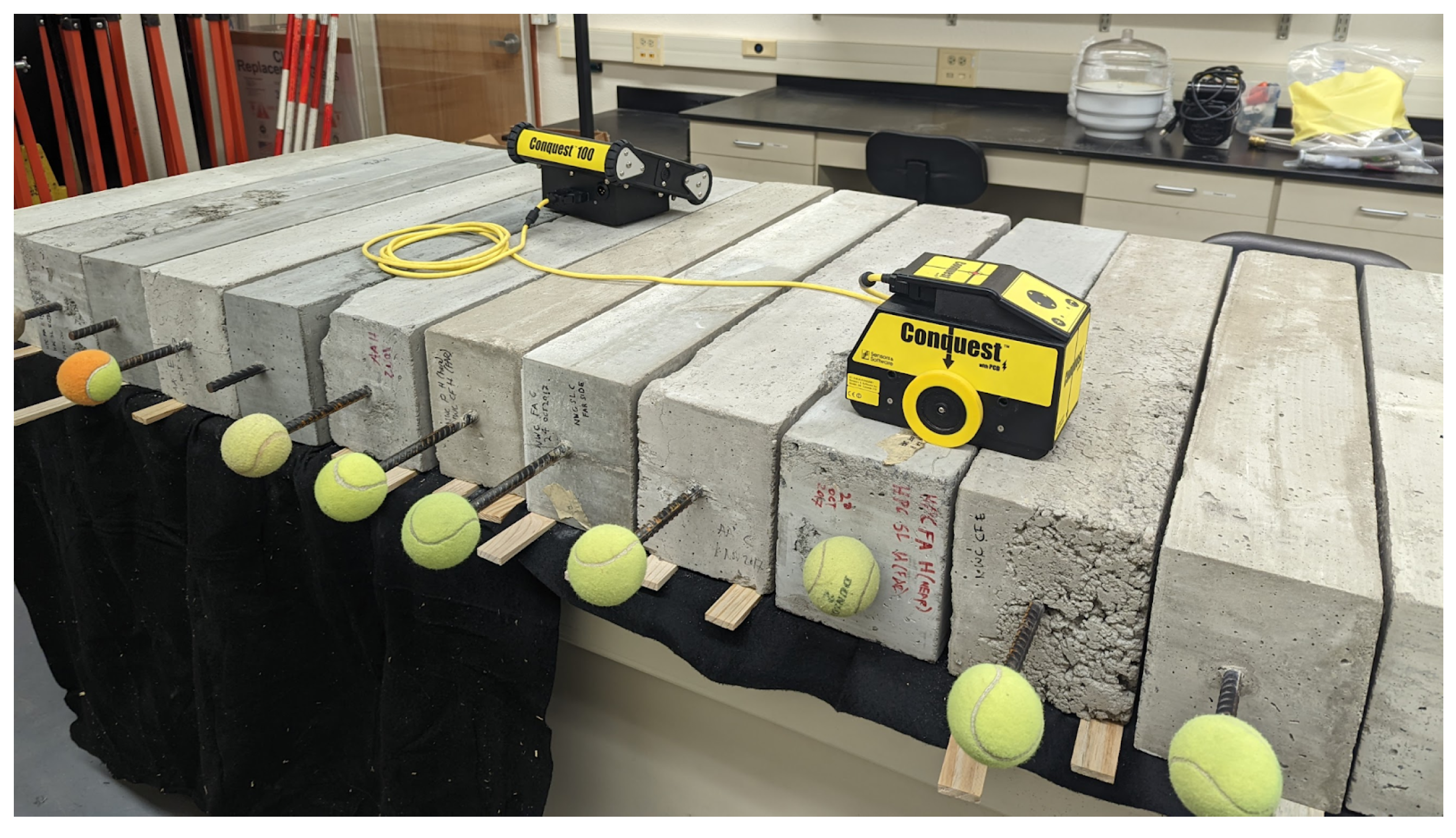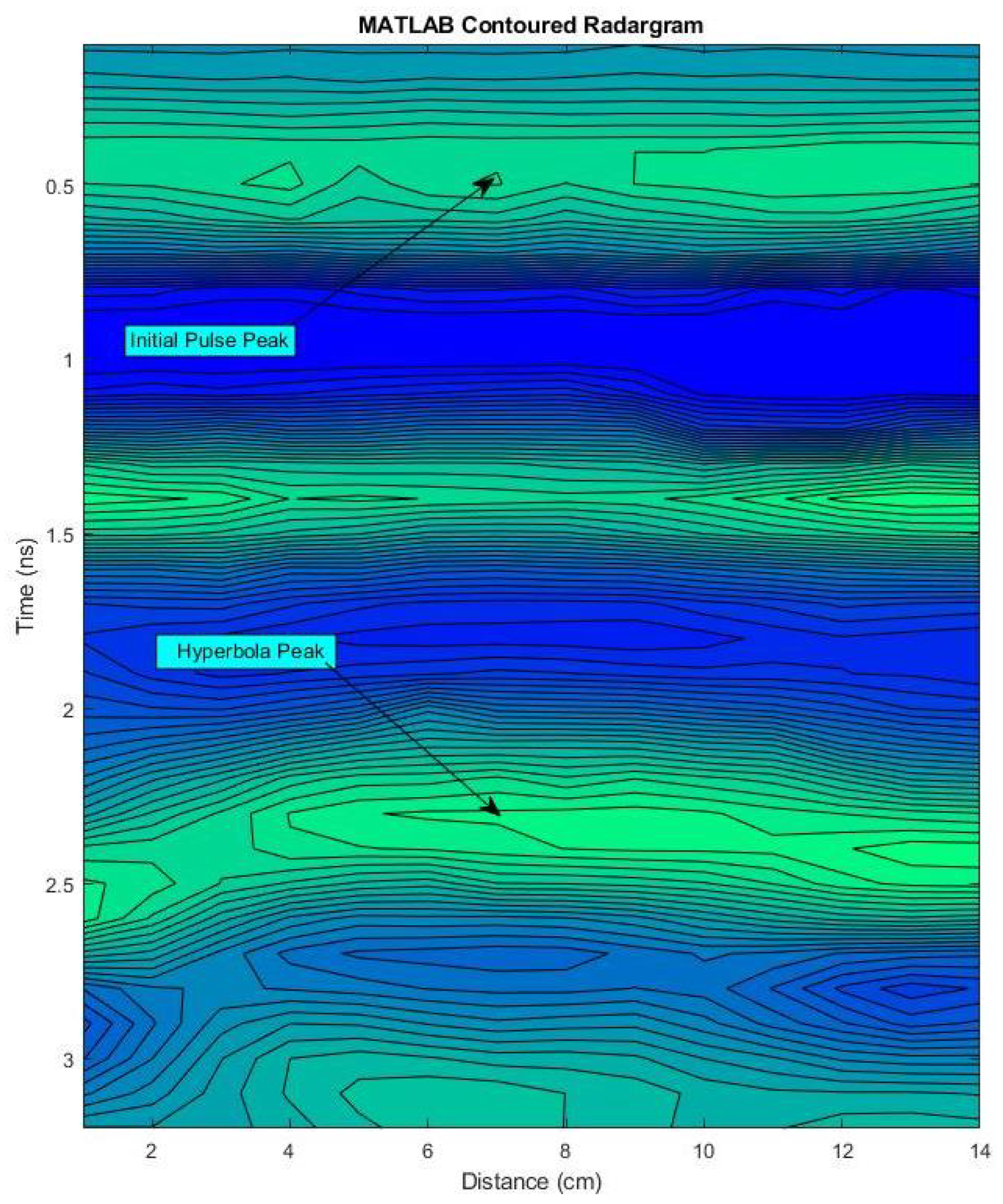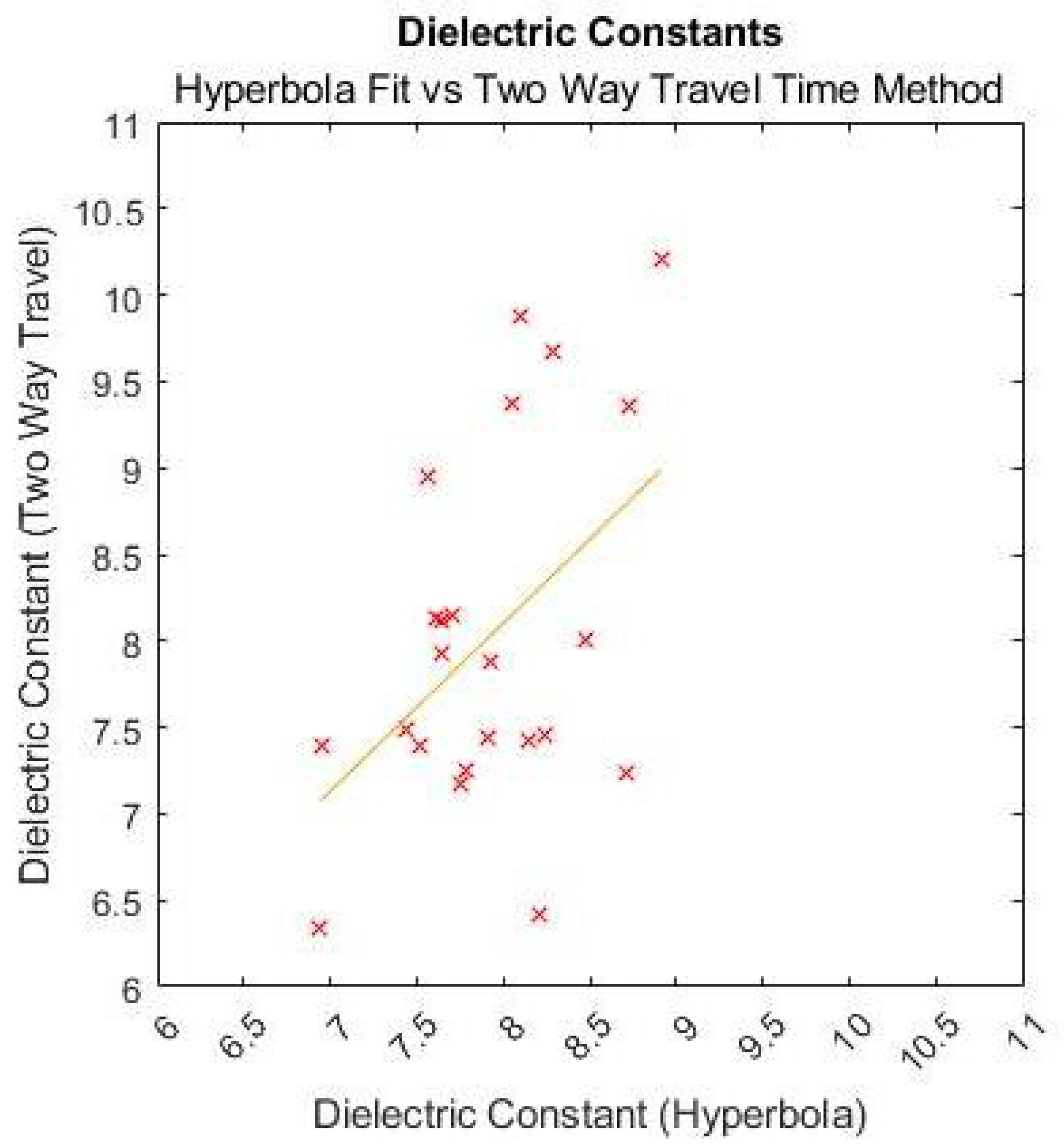Investigating Concrete Properties Using Dielectric Constant from Ground Penetrating Radar Scans
Abstract
1. Introduction
2. Materials and Methods
2.1. Concrete Samples and Tests
2.2. GPR Scanning
2.3. Data Processing
2.4. Repeatability
3. Results
4. Discussion
5. Conclusions
- A relationship does exist between dielectric constant and material properties for normal-weight concrete.
- Dielectric constant is a weak indicator of compressive strength in normal-weight concrete ( = 0.76).
- Density and porosity’s relationships with dielectric constant are mostly inconclusive ( = 0.64 & = 0.52).
- Not all mix designs are applicable to each material property relationship.
- Dielectric constant can be used to determine mix design type.
- The method is repeatable in a controlled environment.
Author Contributions
Funding
Data Availability Statement
Acknowledgments
Conflicts of Interest
Abbreviations
| GPR | Ground penetrating radar |
| SCM | Supplementary cementitious materials |
| AA | Alkali-activated concrete mix |
| HPC | High-performance concrete mix |
References
- 2021 Report Card for America’s Infrastructure. 2021. Available online: https://infrastructurereportcard.org/ (accessed on 5 November 2022).
- Prakash, R. Non-Destructive Testing Techniques; New Age International: New Delhi, India, 2012. [Google Scholar]
- Benedetto, A.; Pajewski, L. Civil Engineering Applications of Ground Penetrating Radar; Springer Transactions in Civil and Environmental Engineering; Springer: Berlin/Heidelberg, Germany, 2015. [Google Scholar] [CrossRef]
- Everett, M.E. Near-Surface Applied Geophysics; Cambridge University Press: Cambridge, UK, 2013. [Google Scholar]
- Morris, I.M.; Kumar, V.; Glisic, B. Predicting material properties of concrete from ground-penetrating radar attributes. Struct. Health Monit. 2020, 20, 147592172097699. [Google Scholar] [CrossRef]
- Senin, S.; Hamid, R. Ground penetrating radar wave attenuation models for estimation of moisture and chloride content in concrete slab. Constr. Build. Mater. 2016, 106, 659–669. [Google Scholar] [CrossRef]
- Lai, W.; Kou, S.; Tsang, W.; Poon, C. Characterization of concrete properties from dielectric properties using ground penetrating radar. Cem. Concr. Res. 2009, 39, 687–695. [Google Scholar] [CrossRef]
- Lai, W.L.; Kind, T.; Wiggenhauser, H. A study of concrete hydration and dielectric relaxation mechanism using ground penetrating radar and short-time Fourier transform. EURASIP J. Adv. Signal Process. 2010, 2010, 317216. [Google Scholar] [CrossRef]
- Dérobert, X.; Villain, G. Development of a multi-linear quadratic experimental design for the EM characterization of concretes in the radar frequency-band. Constr. Build. Mater. 2017, 136, 237–245. [Google Scholar] [CrossRef]
- Chung, K.; Yuan, L.; Ji, S.; Sun, L.; Qu, C.; Zhang, C. Dielectric characterization of Chinese standard concrete for compressive strength evaluation. Appl. Sci. 2017, 7, 177. [Google Scholar] [CrossRef]
- Bungey, J.; Milliard, S.; Grantham, M. Testing of Concrete in Structures; Taylor and Francis: London, UK, 2006. [Google Scholar]
- ASTM. ASTM C 39 Standard Test Method for Compressive Strength of Cylindrical Concrete Specimens; ASTM International: West Conshohocken, PA, USA, 2021. [Google Scholar] [CrossRef]
- Safiuddin, M.; Hearn, N. Comparison of ASTM saturation techniques for measuring the permeable porosity of concrete. Cem. Concr. Res. 2005, 35, 1008–1013. [Google Scholar] [CrossRef]
- Komarov, V.V. Handbook of Dielectric and Thermal Properties of Materials at Microwave Frequencies; Artech House: Boston, MA, USA, 2012. [Google Scholar]









| Base Mix | Normal Weight Concrete | |||||||||||
|---|---|---|---|---|---|---|---|---|---|---|---|---|
| Additives | Flyash (FA) | Slag (SL) | None (CF) | Paste Only (P) | ||||||||
| Curing Condition | E | C | H | E | C | H | E | C | H | E | C | H |
| w/c ratio | 0.41 | 0.41 | 0.41 | 0.41 | ||||||||
| average density (pcf) | 150 | 149 | 150 | 132 | ||||||||
| average porosity | 0.048 | 0.049 | 0.062 | 0.098 | ||||||||
| average strength (MPa) | 46.6 | 35.8 | 43.0 | 55.8 | ||||||||
| Base Mix | High Performance Concrete | Alkali Activated Concrete | ||||||||||
| Additives | Flyash (FA) | Slag (SL) | None (CF) | N/A | ||||||||
| Curing Condition | E | C | H | E | C | H | E | C | H | E | C | H |
| w/c ratio | 0.34 | 0.34 | 0.28 | 0.40 | ||||||||
| average density (pcf) | 152 | 150 | 153 | 136 | ||||||||
| average porosity | 0.039 | 0.036 | 0.022 | 0.099 | ||||||||
| average strength (MPa) | 37.6 | 37.3 | 53.8 | 34.2 | ||||||||
Publisher’s Note: MDPI stays neutral with regard to jurisdictional claims in published maps and institutional affiliations. |
© 2022 by the authors. Licensee MDPI, Basel, Switzerland. This article is an open access article distributed under the terms and conditions of the Creative Commons Attribution (CC BY) license (https://creativecommons.org/licenses/by/4.0/).
Share and Cite
Taylor, J.M.; Morris, I.M. Investigating Concrete Properties Using Dielectric Constant from Ground Penetrating Radar Scans. Infrastructures 2022, 7, 173. https://doi.org/10.3390/infrastructures7120173
Taylor JM, Morris IM. Investigating Concrete Properties Using Dielectric Constant from Ground Penetrating Radar Scans. Infrastructures. 2022; 7(12):173. https://doi.org/10.3390/infrastructures7120173
Chicago/Turabian StyleTaylor, Jonathan M., and Isabel M. Morris. 2022. "Investigating Concrete Properties Using Dielectric Constant from Ground Penetrating Radar Scans" Infrastructures 7, no. 12: 173. https://doi.org/10.3390/infrastructures7120173
APA StyleTaylor, J. M., & Morris, I. M. (2022). Investigating Concrete Properties Using Dielectric Constant from Ground Penetrating Radar Scans. Infrastructures, 7(12), 173. https://doi.org/10.3390/infrastructures7120173









